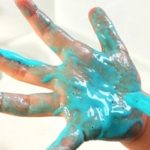I wish I had this recipe when I was little, it would have been so much fun to try! My boys loved playing with paint in the bathtub, as well as painting themselves!
This is a great recipe for bathtub paint, we have used it at our CEFA Early Learning schools to cover ourselves in paint more than once! It is easy to make and easy to wash off and will not stain, so don’t be afraid to give it a try at home. Imagine the fun your child can have while you sit near the bathtub and enjoy a hot cup of coffee.
Best Ages for This Activity
One to five years (they may not want to give it up even when they are five, so you may be making more batches over the years)
How to Make It
You Will Need
- 1 cup of dish soap (make sure your child does not react to the soap you choose as it will be all over their body. If not, use ¼ cup child safe shampoo and ¾ cups child safe conditioner instead)
- ½ cup of cornstarch
- ½ cup of water
- Food colouring or other dye
- Containers to store the paint in once you make it
- A paintbrush (optional, they can use their hands, feet, fingers or any part of their body they choose)
- A saucepan (to cook the paint in)
- A whisk
Let’s get Started
- Invite your child to make bathtub paint with you
- Your child can pour the ½ cup water and the ½ cup cornstarch in a saucepan and mix very well using a whisk or whatever you like, until there are no clumps.
- Take the pan and heat the mixture on medium heat until it boils. Stir constantly to make sure there are no clumps.
- Add the soap and mix, still keeping the heat on medium, until it boils again. Remove from the stove and divide into containers (as many containers as you want colours).
- Your child can carefully mix a few drops of food colouring in each container until they like the intensity of the colour obtained (after they stir it in).
- If you don’t want to use food colouring, you can also use non-toxic tempera paint or any other water-based paint.
- After playing, you can stir the rest of the paint (if you have any left) in an airtight container. It will separate when stored but you can mix it again and it will be good as new.
- Test on a little part of your tub to make sure the food colouring you use does not stain, and then get your child in the bath to paint anything from tiles to tub to body with their new creation.
- In the future, you can make batches of different intensities of blue or yellow for example, instead of several colours – you can try so many things!
Learning Opportunities
Making the paint is a great S.T.E.M. activity, teaching your child science and math. Ensure that your child does most of the work, such as measuring, mixing, pouring, and everything in between (except the parts over the stove or around a hot container), so they really learn those S.T.E.M. concepts hands-on. Use as much math vocabulary as you can, such as:
- How much, how little
- Measurements words
- Intensity
- Counting (drops, for instance)
- Colours
- Etc.
Once the paint is done, it is a nice visual arts and sensory learning activity for your child.
The purpose of visual arts is to invite your child to express themselves, to bring the inside, out, as I like to teach our CEFA Early Learning school Teachers. Your child will discover themselves, the beauty they are capable of expressing through art, and that is an amazing thing to witness – enjoy every moment of it!


Books Your Child Might Like
Toys Your Child Might Like
As an Amazon Associate I earn from qualifying purchases